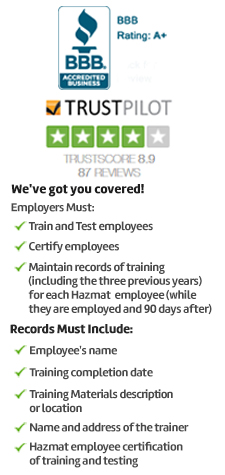
IATA DGR Class 4 Training

This course is formulated in line with the IATA Dangerous Goods Regulations for transporting flammable solids, rules and regulations to be followed by container operators and goods carriers and prescribed norms to screen, identify, register, pack, mark, label, handle, load and unload consignments of highly inflammable goods.
Students learn about the module for Class 4 flammable solids which teaches them the systematic methods to identify, handle and safe transportation of dangerous cargos.
Governing regulations
Al l kinds of combustible solid items sent through air transport are governed by the IATA Class 4 Dangerous Goods Regulations.
This online qualification of transporting hazardous goods provides proof of training to all kinds of air transporters including FedEx and UPS.
Course Overview
This course outlines all basic parameters related to IATA Dangerous Goods Regulations, how to transport hazardous goods safely, rules and regulations for transporters, methods to identify, mark, pack, label and load and unload unsafe cargos at airports. Students learn through statistical data and case studies which will help them to improve knowledge and work skills.
Who Must Take this Course?
As per the IATA DGR regulations, regular training should be given or knowledge testing should be carried out for workers as mentioned in Table 1.5.A, who include: Air cargo screening and acceptance staff, movers and packers, freight handlers, cargo training and development managers; Ground handling and load control workers, specialists who impose regulations at airports, air cargo operations experts, station in charges and security clearance staff.
Course Format
Our IATA Dangerous Goods Regulations Shipping Class 4 certification course contains good quality content, graphical and audio explanation, sample questions for practice and a final exam.
Upon completing the course successfully every candidate will get a hard copy of certification along with an option to print a wallet card.
Continuing education credits?
Each student will receive 0.3 CEUs (or 3 CMEs) for completing this course.
Topics Covered
- About This Course
- Course Objectives
- Introduction to Dangerous Goods Regulations
- Philosophy of Dangerous Goods Regulations
- Key Terms and Concepts
- Dangerous Goods Incidents and Statistics
- How to Use the DGR
- Changes to the 59th Edition
- Applicability
- Basis of the IATA Dangerous Goods Regulations
- Application of the Regulations
- Shipper’s Responsibilities
- Operator’s Responsibilities
- Training
- Adequate Instruction for Shipping Section II Lithium Batteries
- Security
- Limitations
- Forbidden Dangerous Goods
- Hidden Dangerous Goods
- Dangerous Goods Carried by Passengers or Crew
- Dangerous Goods Transported by Post
- Operator’s Property Exceptions
- Excepted Quantities
- Limited Quantities
- Variations
- Classification
- Packing Groups
- Shipper’s Responsibilities
- Multiple Hazards
- Samples
- Identification
- Selecting the Proper Shipping Name
- Using the List of Dangerous Goods
- Packing
- Shipper’s Responsibilities
- Overpacks
- Salvage Packaging
- General Packing Requirements
- Specific Packing Instructions
- Packaging Specifications and Performance Tests
- Codes
- Markings
- Requirements for Inner Packagings
- UN Outer, Single, and Composite Packagings
- General Testing Requirements
- Types of Tests
- Test Reports
- Specific Testing Requirements
- Marking and Labeling
- Markings
- Labels
- General Label Specifications
- Hazard Labels
- Handling Labels
- Documentation
- Shipper’s Declaration
- Completing the Shipper’s Declaration
- Air Waybill
- Additional Documentation
- Handling
- Acceptance
- Loading
- Inspections
- Provisions for Pilot-in-Command
- Informing Passengers and Shippers
- Reporting
- Document Retention
- Class 4 Flammable Solids
- Flammable Solids
- Self-reactive Substances
- Desensitized Explosives
- Division 4.1
- Division 4.2-Substances Liable to Spontaneous Combustion
- Division 4.3-Substances Which, in Contact with Water, Emit Flammable Gases
- Excepted and Limited Quantities
- Packing Instructions
- Summary
- Additional Resources

 NEBOSH CERTIFICATE
NEBOSH CERTIFICATE NEBOSH DIPLOMA
NEBOSH DIPLOMA IOSH
IOSH SAFETY DIPLOMA
SAFETY DIPLOMA CPD UK
CPD UK ROSPA UK
ROSPA UK FOOD SAFETY
FOOD SAFETY 



